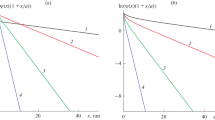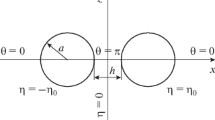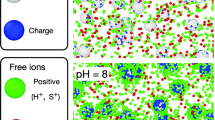Abstract
We study the interaction between two charge regulating spherical macroions with dielectric interior and dissociable surface groups immersed in a monovalent electrolyte solution. The charge dissociation is modelled via the Frumkin-Fowler-Guggenheim isotherm, which allows for multiple adsorption equilibrium states. The interactions are derived from the solutions of the mean-field Poisson-Boltzmann type theory with charge regulation boundary conditions. For a range of conditions we find symmetry breaking transitions from symmetric to asymmetric charge distribution exhibiting annealed charge patchiness, which results in like-charge attraction even in a univalent electrolyte—thus fundamentally modifying the nature of electrostatic interactions in charge-stabilized colloidal suspensions.
Graphic abstract








Similar content being viewed by others
Data Availability Statement
The datasets generated during and/or analysed during the current study are available from the corresponding author on reasonable request.
References
R.H. French, V.A. Parsegian, R. Podgornik, R.F. Rajter, A. Jagota, J. Luo, D. Asthagiri, M.K. Chaudhury, Y.-M. Chiang, S. Granick, S. Kalinin, M. Kardar, R. Kjellander, D.C. Langreth, J. Lewis, S. Lustig, D. Wesolowski, J.S. Wettlaufer, W.-Y. Ching, M. Finnis, F. Houlihan, O.A. von Lilienfeld, C.J. van Oss, T. Zemb, Rev. Mod. Phys. 82, 1887 (2010). https://doi.org/10.1103/RevModPhys.82.1887
W.M. Gelbart, R.F. Bruinsma, P.A. Pincus, V.A. Parsegian, Phys. Today 53, 38 (2000). https://doi.org/10.1063/1.1325230
M. Muthukumar, Physics of Charged Macromolecules (Synthetic and Biological Systems publisher Cambridge University Press, 2023)
P.G. De Gennes, P. Pincus, R.M. Velasco, F. Brochard, J. Phys. France 37, 1461 (1976). https://doi.org/10.1051/jphys:0197600370120146100
M.L. Henle, C.D. Santangelo, D.M. Patel, P.A. Pincus, Europhys. Lett. 66, 284 (2004). https://doi.org/10.1209/epl/i2003-10205-1
A. Dobrynin, M. Rubinstein, Prog. Polym. Sci. 30, 1049 (2005). https://doi.org/10.1016/j.progpolymsci.2005.07.006
G.C. Wong, Curr. Opin. Colloid Interface Sci. 11, 310 (2006). https://doi.org/10.1016/j.cocis.2006.12.003
P. Pincus, Macromolecules 24, 2912 (1991). https://doi.org/10.1021/ma00010a043
M.N. Tamashiro, E. Hernández-Zapata, P.A. Schorr, M. Balastre, M. Tirrell, P. Pincus, J. Chem. Phys. 115, 1960 (2001). https://doi.org/10.1063/1.1381579
C. Schneider, A. Jusufi, R. Farina, F. Li, P. Pincus, M. Tirrell, M. Ballauff, Langmuir 24, 10612 (2008). https://doi.org/10.1021/la802303z
H.-X. Zhou, X. Pang, Chem. Rev. 118, 1691 (2018). https://doi.org/10.1021/acs.chemrev.7b00305
P. Pincus, J.-F. Joanny, D. Andelman, Europhys. Lett. 11, 763 (1990). https://doi.org/10.1209/0295-5075/11/8/012
G. Cevc, in Encyclopedia of Biophysics, edited by G. C. K. Roberts and A. Watts. publisher Springer Berlin Heidelberg 2018) pp. 1446–1452
N. Dan, Colloids Surf., B 27, 41 (2003). https://doi.org/10.1016/S0927-7765(02)00041-3
X. Gao, S. Hong, Z. Liu, T. Yue, J. Dobnikar, X. Zhang, Nanoscale 11, 1949 (2019). https://doi.org/10.1039/C8NR10447F
A.G. Cherstvy, Phys. Chem. Chem. Phys. 13, 9942 (2011). https://doi.org/10.1039/C0CP02796K
A. Šiber, R. Podgornik, Phys. Rev. E 76, 061906 (2007). https://doi.org/10.1103/PhysRevE.76.061906
R. Zandi, B. Dragnea, A. Travesset, R. Podgornik, Phys. Rep. 847, 1 (2020). https://doi.org/10.1016/j.physrep.2019.12.005
M. Dijkstra, E. Luijten, Nat. Mater. 20, 762 (2021). https://doi.org/10.1038/s41563-021-01014-2
E.J. Verwey, J.T.G. Overbeek, Theory of the stability of Lyophobic Colloids (Publisher Elsevier address Amsterdam, 1948)
T. Markovich, D. Andelman, and R. Podgornik, in Handbook of Lipid Membranes, edited by C. R. Safynia and J. O. Raedler ( publisher Taylor and Francis, 2021) pp. 99–128
V.A. Vasileva, D.A. Mazur, Y.A. Budkov, J. Chem. Phys. 159, 024709 (2023). https://doi.org/10.1063/5.0158247
R. Blossey, The Poisson-Boltzmann Equation: An Introduction, Springer Briefs in Physics ( publisher Springer Nature, address Springer Nature Tiergartenstrasse 15 - 17 69121 Heidelberg Germany, 2023)
Y.S. Jho, M. Kanduč, A. Naji, R. Podgornik, M.W. Kim, P.A. Pincus, Phys. Rev. Lett. 101, 188101 (2008). https://doi.org/10.1103/PhysRevLett.101.188101
A. Naji, M. Kanduč, J. Forsman, R. Podgornik, J. Chem. Phys. 139, 150901 (2013). https://doi.org/10.1063/1.4824681
H. Ohshima, Electrical Phenomena at Interfaces and Biointerfaces (Publisher John Wiley and Sons Inc, UK, 2012). https://doi.org/10.1002/9781118135440
A.V. Filippov, A.F. Pal’, A.N. Starostin, A.S. Ivanov, JETP Lett. 83, 546 (2006). https://doi.org/10.1134/s0021364006120058
S.V. Siryk, A. Bendandi, A. Diaspro, W. Rocchia, J. Chem. Phys. 155, 114114 (2021). https://doi.org/10.1063/5.0056120
S.V. Siryk, W. Rocchia, J. Phys. Chem. B 126, 10400 (2022). https://doi.org/10.1021/acs.jpcb.2c05564
D. Andelman, in Handbook of Biological Physics: Structure and Dynamics of Membranes. ed. by R. Lipowsky, E. Sackmann (Publisher Elsevier, 1995), pp.603–642
J. Dobnikar, D. Haložan, M. Brumen, H.-H. Von Grünberg, R. Rzehak, Comput. Phys. Commun. 159, 73 (2004). https://doi.org/10.1016/j.cpc.2003.10.001
J. Dobnikar, Y. Chen, R. Rzehak, H. Von Grünberg, J. Chem. Phys. 119, 4971 (2003). https://doi.org/10.1063/1.1595642
A.L. Kolesnikov, D.A. Mazur, Y.A. Budkov, Europhys. Lett. 140, 16001 (2022). https://doi.org/10.1209/0295-5075/ac9252
M. Borkovec, B. Jönsson, and G. J. M. Koper, in Surface and Colloid Science, edited by E. Matijević (Publisher Springer, 2001) pp. 99–340
A. Naydenov, P.A. Pincus, S.A. Safran, Langmuir 23, 12016 (2007). https://doi.org/10.1021/la702085x
R. Brewster, P.A. Pincus, S.A. Safran, Phys. Rev. Lett. 101, 128101 (2008). https://doi.org/10.1103/PhysRevLett.101.128101
G.M. Ong, A. Gallegos, J. Wu, Langmuir 36, 11918 (2020). https://doi.org/10.1021/acs.langmuir.0c02000
A. Gallegos, J. Wu, J. Chem. Eng. Data 65, 5630 (2020). https://doi.org/10.1021/acs.jced.0c00625
P. Khunpetch, A. Majee, R. Podgornik, Soft Matter 18, 2597 (2022). https://doi.org/10.1039/D1SM01665B
P. Khunpetch, A. Majee, H. Ruixuan, R. Podgornik, Phys. Rev. E 108, 024402 (2023). https://doi.org/10.1103/PhysRevE.108.024402
I. Popa, P. Sinha, M. Finessi, P. Maroni, G. Papastavrou, M. Borkovec, Phys. Rev. Lett. 104, 228301 (2010). https://doi.org/10.1103/PhysRevLett.104.228301
M. Lund, B. Jönsson, Q. Rev, Biophys. 46, 265 (2013). https://doi.org/10.1017/S003358351300005X
G. Trefalt, S.H. Behrens, M. Borkovec, Langmuir 32, 380 (2016). https://doi.org/10.1021/acs.langmuir.5b03611
G. Trefalt, T. Palberg, M. Borkovec, Curr. Opin. Colloid Interface Sci. 27, 9 (2017). https://doi.org/10.1016/j.cocis.2016.09.008
Y. Avni, D. Andelman, R. Podgornik, Curr. Opin. Electrochem. 13, 70 (2019). https://doi.org/10.1016/j.coelec.2018.10.014
A. Kubincová, P.H. Hünenberger, M. Krishnan, J. Chem. Phys. 152, 104713 (2020). https://doi.org/10.1063/1.5141346
N. Adžić, R. Podgornik, Eur. Phys. J. E 37, 49 (2014). https://doi.org/10.1140/epje/i2014-14049-6
N. Adžić, R. Podgornik, Phys. Rev. E 91, 022715 (2015). https://doi.org/10.1103/PhysRevE.91.022715
N. Adžić, R. Podgornik, J. Chem. Phys. 144, 214901 (2016). https://doi.org/10.1063/1.4952980
S.H. Behrens, M. Borkovec, J. Phys. Chem. B 103, 2918 (1999). https://doi.org/10.1021/jp984099w
P.M. Biesheuvel, J. Colloid Interface Sci. 275, 514 (2004). https://doi.org/10.1016/j.jcis.2004.02.069
M. Borkovec, S.H. Behrens, J. Phys. Chem. B 112, 10796 (2008). https://doi.org/10.1021/jp805595z
T. Obstbaum, U. Sivan, Langmuir 38, 8477 (2022). https://doi.org/10.1021/acs.langmuir.2c01352
D. Chan, T.W. Healy, L.R. White, J. Chem. Soc., Faraday Trans. 72, 2844 (1976). https://doi.org/10.1039/F19767202844
D. McCormack, S.L. Carnie, D.Y.C. Chan, J. Colloid Interface Sci. 169, 177 (1995). https://doi.org/10.1006/jcis.1995.1019
S.H. Behrens, M. Borkovec, Phys. Rev. E 60, 7040 (1999). https://doi.org/10.1103/PhysRevE.60.7040
D.Y.C. Chan, T.W. Healy, T. Supasiti, S. Usui, J. Colloid Interface Sci. 296, 150 (2006). https://doi.org/10.1016/j.jcis.2005.09.003
N. Boon, R. van Roij, J. Chem. Phys. 134, 054706 (2011). https://doi.org/10.1063/1.3533279
M. Krishnan, J. Chem. Phys. 146, 205101 (2017). https://doi.org/10.1063/1.4983485
A. Behjatian, R. Walker-Gibbons, A.A. Schekochihin, M. Krishnan, Langmuir 38, 786 (2022). https://doi.org/10.1021/acs.langmuir.1c02801
E. Reiner, C. Radke, Adv. Colloid Interface Sci. 47, 59 (1993). https://doi.org/10.1016/0001-8686(93)80014-3
R. Ettelaie, R. Buscall, Adv. Colloid Interface Sci. 61, 131 (1995). https://doi.org/10.1016/0001-8686(95)00263-P
F.R. Zypman, Langmuir 38, 3561 (2022). https://doi.org/10.1021/acs.langmuir.2c00141
J.E. Sader, D.Y.C. Chan, J. Colloid Interface Sci. 213, 268 (1999). https://doi.org/10.1006/jcis.1999.6131
J.C. Neu, Phys. Rev. Lett. 82, 1072 (1999). https://doi.org/10.1103/PhysRevLett.82.1072
E. Trizac, J.-L. Raimbault, Phys. Rev. E 60, 6530 (1999). https://doi.org/10.1103/PhysRevE.60.6530
A. Majee, M. Bier, R. Podgornik, Soft Matter 14, 985 (2018). https://doi.org/10.1039/c7sm02270k
A. Majee, M. Bier, R. Blossey, R. Podgornik, Phys. Rev. E 100, 050601 (2019). https://doi.org/10.1103/PhysRevE.100.050601
A. Majee, M. Bier, R. Blossey, R. Podgornik, Phys. Rev. Research 2, 043417 (2020). https://doi.org/10.1103/PhysRevResearch.2.043417
D. Harries, R. Podgornik, V.A. Parsegian, E. Mar-Or, D. Andelman, J. Chem. Phys. 124, 224702 (2006). https://doi.org/10.1063/1.2198534
J. Yuan, K. Takae, H. Tanaka, Phys. Rev. Lett. 128, 158001 (2022). https://doi.org/10.1103/PhysRevLett.128.158001
M.M. Baksh, M. Jaros, J.T. Groves, Nature 427, 139 (2004). https://doi.org/10.1038/nature02209
E.W. Gomez, N.G. Clack, H.-J. Wu, J.T. Groves, Soft Matter 5, 1931 (2009). https://doi.org/10.1039/B821510C
L. Javidpour, A. Božič, A. Naji, R. Podgornik, Soft Matter 17, 4296 (2021). https://doi.org/10.1039/d1sm00232e
A.V. Finkelstein, Protein Physics (Second Edition ( publisher Elsevier, 2016). https://doi.org/10.13140/RG.2.1.1319.8320
R.A. Marcus, J. Chem. Phys. 23, 1057 (1955). https://doi.org/10.1063/1.1742191
R. Podgornik, J. Chem. Phys. 149, 104701 (2018). https://doi.org/10.1063/1.5045237
L. Koopal, W. Tan, M. Avena, Adv. Colloid Interface Sci. 280, 102138 (2020). https://doi.org/10.1016/j.cis.2020.102138
A. Abin-Bazaine, A. C. Trujillo, and M. Olmos-Marquez, in Wastewater Treatment, edited by M. Ince and O. K. Ince ( publisher IntechOpen, address Rijeka, 2022) Chap. chapter 2 https://doi.org/10.5772/intechopen.104260
I. Teraoka, Polymer solutions: An Introduction to Physical Properties (Publisher John Wiley and Sons Inc, address New York, 2002)
Y. Avni, R. Podgornik, D. Andelman, J. Chem. Phys. 153, 024901 (2020). https://doi.org/10.1063/5.0011623
Y. Avni, T. Markovich, R. Podgornik, D. Andelman, Soft Matter 14, 6058 (2018). https://doi.org/10.1039/c8sm00728d
B.W. Ninham, V.A. Parsegian, J. Theor. Biol. 31, 405 (1971). https://doi.org/10.1016/0022-5193(71)90019-1
J. Landsgesell, L. Nová, O. Rud, F. Uhlík, D. Sean, P. Hebbeker, C. Holm, P. Košovan, Soft Matter 15, 1155 (2019). https://doi.org/10.1039/C8SM02085J
J. Landsgesell, P. Hebbeker, O. Rud, R. Lunkad, P. Košovan, C. Holm, Macromolecules 53, 3007 (2020). https://doi.org/10.1021/acs.macromol.0c00260
A. Bakhshandeh, D. Frydel, Y. Levin, Phys. Chem. Chem. Phys. 22, 24712 (2020). https://doi.org/10.1039/D0CP03633A
A. Bakhshandeh, D. Frydel, Y. Levin, Langmuir 38, 13963 (2022). https://doi.org/10.1021/acs.langmuir.2c02313
L. Fink, J. Feitelson, R. Noff, T. Dvir, C. Tamburu, U. Raviv, Langmuir 33(23), 5636 (2017). https://doi.org/10.1021/acs.langmuir.7b00596
L. Fink, A. Steiner, O. Szekely, P. Szekely, U. Raviv, Langmuir 35, 9694 (2019). https://doi.org/10.1021/acs.langmuir.9b00778
J. Schwinger, L. L. Deraad, K. A. Milton, W.-Y. Tsai, and J. Norton, Classical Electrodynamics, Frontiers in Physics ( publisher Westview Press, address Philadelphia, PA, 1998)
A.C. Maggs, R. Podgornik, Soft Matter 12, 1219 (2016). https://doi.org/10.1039/c5sm01757b
J.T.G. Overbeek, Colloids and Surfaces 51, 61 (1990). https://doi.org/10.1016/0166-6622(90)80132-n
G. Lamm, title The poisson–boltzmann equation, in Reviews in Computational Chemistry ( publisher John Wiley and Sons, Ltd, 2003) Chap. chapter 4, pp. 147–365 https://doi.org/10.1002/0471466638.ch4
A. Majee, M. Bier, S. Dietrich, J. Chem. Phys. 145, 064707 (2016). https://doi.org/10.1063/1.4960623
R. Bebon, A. Majee, J. Chem. Phys. 153, 044903 (2020). https://doi.org/10.1063/5.0013298
J. Landsgesell, P. Hebbeker, O. Rud, R. Lunkad, P. Košovan, C. Holm, Macromolecules 53, 3007 (2020). https://doi.org/10.1021/acs.macromol.0c00260
E. J. Verwey and J. T. G. Overbeek, Theory of the stability of Lyophobic Colloids ( publisher Elsevier, address Amsterdam, 1948)
Y.A. Budkov, A.L. Kolesnikov, J. Stat. Mech: Theory Exp. 2022, 053205 (2022). https://doi.org/10.1088/1742-5468/ac6a5b
P.E. Brandyshev, Y.A. Budkov, J. Chem. Phys. 158, 174114 (2023). https://doi.org/10.1063/5.0148466
R. Podgornik, Chem. Phys. Lett. 163, 531 (1989). https://doi.org/10.1016/0009-2614(89)85181-4
A.A. Kornyshev, D.A. Kossakowski, S. Leikin, J. Chem. Phys. 97, 6809 (1992). https://doi.org/10.1063/1.463634
J. Wu, Chem. Rev. 122, 10821 (2022). https://doi.org/10.1021/acs.chemrev.2c00097
Y.A. Budkov, A.L. Kolesnikov, Curr. Opin. Electrochem. 33, 100931 (2022). https://doi.org/10.1016/j.coelec.2021.100931
J. Huang, JACS Au 3, 550 (2023). https://doi.org/10.1021/jacsau.2c00650
R. Kjellander, Phys. Chem. Chem. Phys. 22, 23952 (2020). https://doi.org/10.1039/D0CP02742A
R. Zhang, B.I. Shklovskii, Phys. Rev. E 72, 021405 (2005). https://doi.org/10.1103/PhysRevE.72.021405
J. Lekner, Proc. R. Soc. A 468, 2829 (2012). https://doi.org/10.1098/rspa.2012.0133
L. Zhang, H. Davis, A. Kornyshev, D. Kroll, Chem. Phys. Lett. 229, 638 (1994). https://doi.org/10.1016/0009-2614(94)01099-4
M. Krishnan, I. Mönch, P. Schwille, Nano Lett. 7, 1270 (2007). https://doi.org/10.1021/nl0701861
A. Klaassen, F. Liu, F. Mugele, I. Siretanu, Langmuir 38, 914 (2022). https://doi.org/10.1021/acs.langmuir.1c02077
F.L. Barroso da Silva, B. Jönsson, Soft Matter 5, 2862 (2009). https://doi.org/10.1039/B902039J
F. L. Barroso da Silva, in Reference Module in Chemistry, Molecular Sciences and Chemical Engineering, ( publisher Elsevier, 2023)
B.K. Radak, C. Chipot, D. Suh, S. Jo, W. Jiang, J.C. Phillips, K. Schulten, B. Roux, J. Chem. Theory Comput. 13, 5933 (2017). https://doi.org/10.1021/acs.jctc.7b00875
T. Curk, J. Yuan, E. Luijten, J. Chem. Phys. 156, 044122 (2022). https://doi.org/10.1063/5.0066432
N. Aho, P. Buslaev, A. Jansen, P. Bauer, G. Groenhof, B. Hess, J. Chem. Theory Comput. 18, 6148 (2022). https://doi.org/10.1021/acs.jctc.2c00516
V. Martins de Oliveira, R. Liu, J. Shen, Curr. Opin. Struct. Biol. 77, 102498 (2022). https://doi.org/10.1016/j.sbi.2022.102498
P. Buslaev, N. Aho, A. Jansen, P. Bauer, B. Hess, G. Groenhof, J. Chem. Theory Comput. 18, 6134 (2022). https://doi.org/10.1021/acs.jctc.2c00517
A. Bakhshandeh, A.P. dos Santos, Y. Levin, J. Phys. Chem. B 124, 11762 (2020). https://doi.org/10.1021/acs.jpcb.0c09446
Acknowledgements
HR and RP acknowledge funding from the Key Project No. 12034019 of the National Natural Science Foundation of China and the 1000-Talents Program of the Chinese Foreign Experts Bureau and the School of Physics, University of Chinese Academy of Sciences. J.D. acknowledges funding from the Chinese National Science Foundation (Grants 11874398, 12034019) and from the Strategic Priority Research Program of the Chinese Academy of Sciences (XDB33000000).
Author information
Authors and Affiliations
Contributions
RP and JD formulated the problem. RH did the calculations. AM did the analysis of the results. All the authors contributed equally to the writing of the paper.
Corresponding author
Additional information
Dedicated to the legacy of fundamental contributions of Fyl Pincus to macromolecular electrostatics that have enlightened our understanding of complex (bio)molecular systems and have inspired and continue to inspire the soft-matter community.
Appendices
Appendix A: Alternative forms of the free energy
In this appendix we derive alternative forms of the free energy that do not contain the derivatives of the electrostatic potential.
Inserting the Euler-Lagrange equations back into the free energy Eq. (7) we obtain the equilibrium free energy as
This can be rewritten in a fully symmetric form that as far as we know has not yet been derived in the PB literature. In fact, introducing
which is proportional to the (negative) osmotic pressure of the mobile ions, we obtain
This form of the free energy is particularly apt for numerical calculations since it contains only the electrostatic potential and the surface charge fraction, but does not contain any derivatives of these fields. We can rework this form of the free energy further by inserting the result of Eqs. (12) that yields
a form valid at each of the macroion surfaces 1, 2. From here it also follows that
a Plot of the charge asymmetry \(\vert \phi _{1}-\phi _2\vert \) for \(A = \kappa _D \ell _B/(4\pi )\frac{e^{-\kappa _D D}}{\kappa _D D } = 3\) as a function of \(\alpha \) and \(\chi \) for two point macroions. The case \(\vert \phi _{1}-\phi _2\vert = 0\), corresponds to a symmetric branch of the solution, while the charge symmetry broken state corresponds to \(\vert \phi _{1}-\phi _2\vert \ne 0\). The line represents the critical dissociation “isotherm” \(\alpha = -{\textstyle \frac{1}{2}}\chi \). b Plot of the force \(-\partial _D{{{\mathcal {F}}}}(D)\) in the units of \(\kappa _D^2 \ell _B/(4\pi )\) as a function of \(u = \kappa _D D\). \(\alpha = -2\) and \(\chi = 10, 7, 6, 5, 4\) (top to bottom curves). The charge symmetry transitions between the symmetric and asymmetric branches of the solution are now translated into a discontinuous jump in the interaction force from repulsion to attraction. Note that this discontinuity moves to larger spacing as \(\chi \) decreases
valid at each of the macroion surfaces 1, 2 and therefore combining the two together we remain with
again valid at each of the macroion surfaces 1, 2. Inserting this into Eq. (A1) we finally obtain the form of the free energy most suitable for numerical calculations
This is a rather simple free energy expression that can be straightforwardly used in numerical calculations specifically in the context of charge regulation. It remains valid with or without the \(\chi \) term, and therefore also in the case of the Langmuir dissociation isotherm for \(\chi = 0\). Again, we note that since this free energy contains no derivatives, it is a practical formulation for numerical computation.
Note that in the absence of CR—for constant values of the surface charge densities \(\sigma _{1,2}\)—the above free energy reduces to the form equivalent to the one derived by Overbeek [59, 92]
Appendix B: Point charge limit
We proceed by casting the electrostatic part of the free energy of the two macroions in the limit of point charges into a much simplified form that can be derived from the Casimir charging process
where the limit indicates the point-like macroion approximation, with \(e = e_0 ~(\phi -{\textstyle \frac{1}{2}})\), and the electrostatic potential is given by the DH expression for two point charges separated by D, yielding finally the electrostatic free energy in the form
Clearly, the terms linear in \(\phi _{1,2}\) simply renormalize \(\alpha \) and the terms quadratic in \(\phi _{1,2}\) renormalize \(\chi \) in the expression for the total free energy, Eq. (15),
A renormalized and rescaled free energy is then of the form
where \(\ell _{B}\) is again the Bjerrum length. One should note the difference between the above free energy and the Langmuir isotherm model used in Adžić et al. [47,48,49]. The equilibrium state is obtained numerically—by minimizing \({{{\mathcal {F}}}} [\phi _1, \phi _2]\) with respect to \(\phi _{1,2}\):
The equilibrium free energy exhibits a separation dependence \({{{\mathcal {F}}}} [\phi _1(D), \phi _2(D)] \longrightarrow {{{\mathcal {F}}}}(D)\), and the interaction force is \(f=- \partial _D {{{\mathcal {F}}}}(D)\).
The dependence of free energy on the (dimensionless) separation \(\kappa _D D\) is shown in Fig. 8. Figure 8a displays the charge asymmetry proportional to \(\vert \phi _{1}-\phi _2\vert \) as a function of \((\alpha ,\chi )\) at fixed D. In fact the case \(\vert \phi _{1}-\phi _2\vert = 0\), corresponds to a symmetric branch of the solution, while the \(\vert \phi _{1}-\phi _2\vert \ne 0\) corresponds to charge symmetry broken state. The line in Fig. 8a represents the critical dissociation “isotherm” \(\alpha = -{\textstyle \frac{1}{2}}\chi \). Clearly, there is an island of asymmetry in the see of symmetric charge partitioning. The boundary of this island of asymmetry exhibits either a continuous or discontinuous transition from the symmetric to an asymmetric state, which is reflected in the behavior of \({{{\mathcal {F}}}}(D)\) in Fig. 8b that shows the interaction force dependence on \(\kappa _D D\) for fixed \((\alpha ,\chi )\).
Rights and permissions
Springer Nature or its licensor (e.g. a society or other partner) holds exclusive rights to this article under a publishing agreement with the author(s) or other rightsholder(s); author self-archiving of the accepted manuscript version of this article is solely governed by the terms of such publishing agreement and applicable law.
About this article
Cite this article
Ruixuan, H., Majee, A., Dobnikar, J. et al. Electrostatic interactions between charge regulated spherical macroions. Eur. Phys. J. E 46, 115 (2023). https://doi.org/10.1140/epje/s10189-023-00373-9
Received:
Accepted:
Published:
DOI: https://doi.org/10.1140/epje/s10189-023-00373-9





